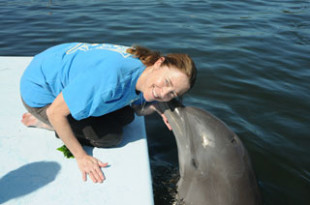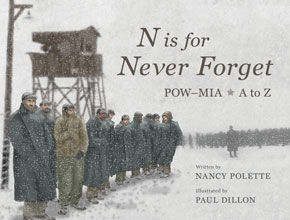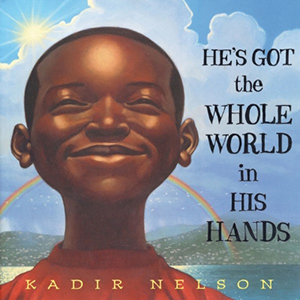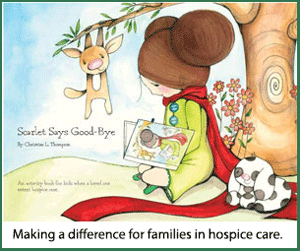The cries of birds create background music as Mary Alice Monroe—at her home on the Isle of Palms, a barrier island near Charleston, South Carolina—talks about her passion for nature and stories.
The author of twenty books, most of them set in coastal Carolina, doesn’t mind if the books she writes are labeled “beach reads.” In fact, she hopes that is exactly where her books will be read.
“I don’t care what they call it,” she says, “but I want them to pick up that book—hopefully while they’re on vacation at the beach, looking at the shorebirds out there.”
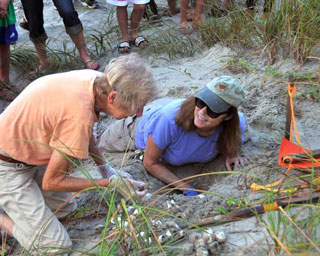
Mary Alice and other members of the Island Turtle Team do all they can to protect the nesting sites of sea turtles on the Isle of Palms and Sullivan’s Island, barrier islands near Charleston, SC. Here, Mary Alice (wearing blue shirt) and other volunteers are preparing to move a nest of loggerhead sea turtle eggs to higher ground for safety. Photo by Barb Bergwerf.
She hopes her readers will take a closer look at the natural world and the ways humans can make a positive difference in it. Her latest book, Beach House for Rent, due out in June 2017, includes themes related to shorebirds, like pelicans and sandpipers, whose nesting and feeding areas are under increasing pressure from beach-going crowds, pollution, and land development.
Since her first bestseller The Beach House, in 2002, Mary Alice has incorporated environmental issues into her novels. In that book, her characters and plot were interwoven with the struggles of loggerhead sea turtles, which come ashore to nest in Mary Alice’s own beach neighborhood.
For nearly a decade, she has been an integral part of the Island Turtle Team, a group of resident volunteers who protect turtles nesting on the Isle of Palms and nearby Sullivan’s Island. Working with the South Carolina Department of Natural Resources, Mary Alice and her cohorts track and protect sea turtles and their nesting sites.
She is also a board member emeritus of the South Carolina Aquarium in Charleston, and serves on the board of the Leatherback Trust, an international organization that works to protect various species of sea turtles.
Mary Alice is an environmentalist, and she is a storyteller. She wants her stories to make readers aware of environmental concerns without filling her pages with sobering facts and statistics.
“I never forget I’m a novelist first,” she says emphatically. “My readers want a good story. If they wanted a book about shorebirds, they would pick up a nonfiction book. Through story I like to make my readers aware of the passion I feel. I hope I touch my readers with imagination and story, because they’ll remember that.”
Telling the story is paramount for Mary Alice, but her process for creating a novel begins with choosing a species or environmental issue. Although Mary Alice says that choice is based on her “intuition,” a conversation with her reveals that her intuition is firmly rooted in a lifetime of activism and advocacy. Her novels have incorporated the lives of monarch butterflies, various types of fish, mammals, birds, and reptiles, as well as endangered habitats, like maritime forests.
After choosing the natural basis for her story, she employs a systematic and multi-pronged approach: academic research into the species or habitat, followed by interviews with experts on the topic, and always hands-on experience.
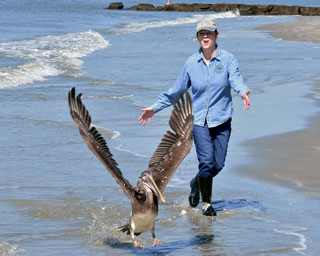
In March 2017, Mary Alice was invited by the Center for Birds of Prey to participate in the release of the young pelican she had rescued the previous fall. Although the bird walked out toward the water with Mary Alice and spread its wings, the pelican did not want to fly away that day. “I fear she is habituated to humans and won’t make it in the wild,” says Mary Alice. “Without a flock to support her, she’d fail to thrive.” The bird will be taken to a protected environment where she can live with other non-releasable pelicans.
“I roll up my sleeves and become a volunteer,” she says. “I never write a book about anything unless I’ve worked with a species myself, not only to learn about the animal, but to learn the truth about the people who are involved in protecting it.”
She’s done research for her books alongside other environmental organizations as well, like the Dolphin Research Center in Grassy Key, Florida, the National Oceanic and Atmospheric Administration, and the Center for Birds of Prey at the Avian Conservation Center in Awendaw, South Carolina.
Though based on environmental research, her books are not academic. Instead, they lean closely into the personal struggles of her human characters. Mary Alice uses what she learns about her chosen species to create those characters, and to determine theme, plot, and metaphor.
“I create characters with issues that sometimes parallel the issues in nature. When I turn the pages as a writer, I’m writing about the people—what makes them struggle and cry. I don’t have to pound it into my readers’ heads. That’s the power of a good story.”
Mary Alice found plenty of story material from the lives of her neighbors, the sea turtles, who return to the place they were born to lay their eggs, then leave again. They don’t return to care for their eggs or hatchlings, who must find their own way from a nest on shore out to the sea.
“I knew one of my characters would return home. With turtles, there were a lot of nests and eggs and fecundity, so I knew someone would be pregnant,” she says. “The mother turtle camouflages her nest to protect it, but she doesn’t return to the nest, so I knew abandonment would be an issue.”
In her latest book, Mary Alice draws on the lives and habitats of birds—from caged canaries to wild pelicans—to address human issues of isolation, from one another as well as from the natural world. She feels people—as they become ever more tethered to technology—are becoming disconnected from nature.
“We don’t know what wild is any more. We can’t even identify the birds we see,” Mary Alice says. “So many of us spend so much of our time indoors looking out at nature through glass, which is a metaphor for a cage. Like one of my characters, we put our hands against the glass, and we want to go out to feel the breeze on our cheeks, but something holds us back.”
That something, she says, is fear—created by a cycle of avoidance and inaccessibility. The more people stay indoors away from nature, the more they withdraw from it as something unknown. As she intertwines natural themes with character and plot, Mary Alice believes people should be more intertwined with the environment.
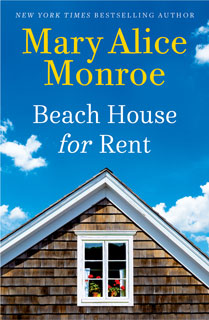 “This book (Beach House for Rent) is really about becoming connected, not only to the outdoors but to each other. For my character, being outdoors heals her. I really believe your connection to nature affects your ability to connect with other humans,” Mary Alice says.
“This book (Beach House for Rent) is really about becoming connected, not only to the outdoors but to each other. For my character, being outdoors heals her. I really believe your connection to nature affects your ability to connect with other humans,” Mary Alice says.
For Mary Alice, connection with nature appears to translate smoothly into connection with fellow humans, namely her readers, who have made her a bestselling author several times over. When Mary Alice speaks to a crowd or when she interacts with an individual, she’s engaged. Personal issues are as important to her as environmental ones, and she connects easily, on and off the page.
The letters she received from readers after the success of The Beach House were more often about personal relationships than environmental issues.
“The letters said things like, ‘I just read your book, and I called my mother for the first time in ten years,’” she says. “It isn’t just about the turtles. It’s all about emotion and storytelling, and then you let the truth—like a parable—come through.”
Her love of storytelling and her love of nature are intertwined as well. Mary Alice says she was born with a desire to write stories, a desire that was sparked by her love of nature.
After living for many years in Washington, D.C., Mary Alice and her husband moved to the coast of South Carolina about twenty years ago.
“I felt when I came to South Carolina, I had come home,” she says. “This area is rich in culture as well as landscape. You can’t have one without the other. If you don’t understand nature, you don’t really understand the culture.”
She calls the Charleston area “Mecca for an environmentalist,” because of the variety of ecosystems, from shorelines and wetlands, to the foothills of the Smoky Mountains, less than a day’s drive away.
Mary Alice has written picture books about nature for children and plans to create books for middle grade readers soon. She writes her books—for readers of all ages—to create awareness and concern for their environment, but she doesn’t tell anyone how to think.
“I like to raise questions and offer possible solutions, but I never tell my readers what to do. The answers come from the reader’s self. They not only read it, they feel it and act on it. When they go to the beach maybe they’ll pick up their trash…leash their dogs so they don’t disturb the shorebirds. If they learn that through story…if I instill curiosity in my readers, then I hope they go to nonfiction and learn more.”
Mary Alice, it seems, is always hungry to learn more. If her latest research is any indication, her next book may take readers on an inland journey.
“I just came back from the mountains, working with animals for two weeks,” she says. “I’m filled with stories.”
Web: MaryAliceMonroe.com
Facebook: /MaryAliceMonroe
Twitter: @MaryAliceMonroe
Feature photo: As part of the research for one of her books, Mary Alice Monroe volunteered at the Dolphin Research Center in Grassy Key, Florida. A dolphin named Jax, who lives at the center, shows his appreciation. Photo courtesy of Mary Alice Monroe.
Terri Barnes is a writer who has also found a home in South Carolina, where her neighbors include egrets, owls, turtles, and ducks. She is the author of Spouse Calls: Messages From a Military Life.

